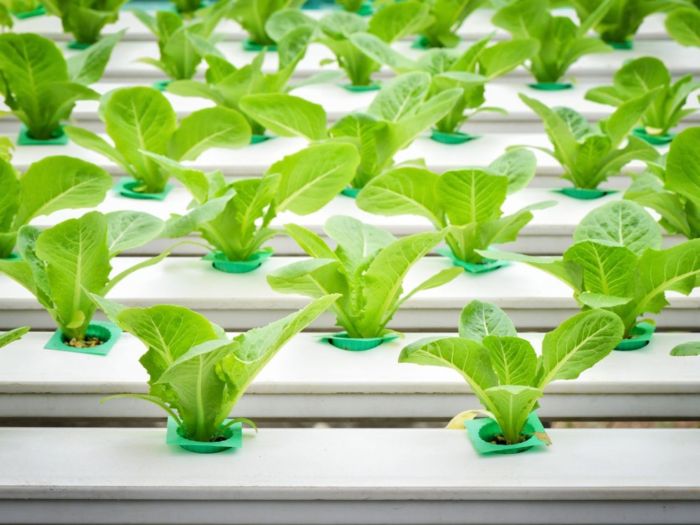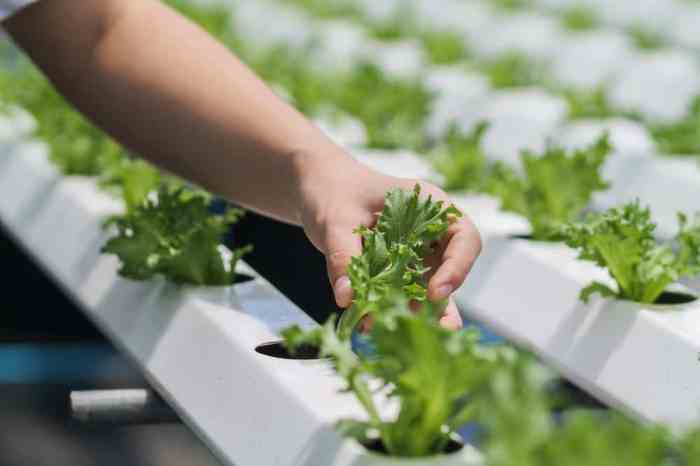Best plants to grow with hydroponics – Discover the world of hydroponics and explore the best plants to grow in this innovative gardening system. With hydroponics, you can unlock the secrets of high-yield gardening, faster growth rates, and efficient water conservation.
From nutrient-rich leafy greens to vibrant fruiting plants, this guide will delve into the ideal candidates for hydroponic cultivation, providing insights into their specific requirements and the benefits they offer.
Benefits of Hydroponics

Hydroponics, a method of growing plants without soil, offers numerous advantages over traditional soil-based gardening. By controlling the nutrient solution and environmental factors, hydroponics enables plants to thrive in an optimized environment, resulting in several key benefits.
One significant advantage of hydroponics is the increased yield. Plants grown hydroponically often produce higher yields compared to soil-based cultivation. This is attributed to the efficient delivery of nutrients and water directly to the plant’s roots, eliminating competition from soil microorganisms and reducing stress on the plant.
Another benefit is faster growth rates. Hydroponic systems provide plants with a constant supply of nutrients and water, allowing them to grow at an accelerated pace. This can lead to shorter production cycles and increased productivity, making hydroponics an attractive option for commercial growers.
Hydroponics also promotes water conservation. Unlike traditional soil-based gardening, which requires significant water for irrigation, hydroponic systems utilize a closed-loop system that recirculates water and nutrients. This significantly reduces water consumption, making hydroponics an environmentally sustainable method of plant cultivation.
While hydroponics offers a controlled environment for growing plants, choosing the right species is crucial. Lettuce, tomatoes, and herbs thrive in hydroponic systems, providing fresh produce indoors. For those seeking inspiration on greenery and decor, Discover the Allure of Indoor Plant Stores: A Guide to Greenery and Decor offers valuable insights into the world of indoor plants and their aesthetic appeal.
Returning to hydroponics, consider leafy greens and root vegetables for optimal growth and nutrient uptake in your controlled environment.
Ideal Plants for Hydroponics

Hydroponic systems offer optimal conditions for plant growth, making them ideal for cultivating a wide range of plant species. The selection of suitable plants for hydroponics depends on factors such as nutrient requirements, pH levels, and light intensity.
Hydroponic systems can accommodate plants with varying nutrient demands. Fast-growing plants like lettuce, basil, and strawberries require higher nutrient levels, while slower-growing plants like tomatoes, peppers, and cucumbers need moderate to low nutrient concentrations.
pH Levels
The pH level of the nutrient solution is crucial for plant growth. Most plants thrive in a pH range of 5.5 to 6.5, with some exceptions. For instance, tomatoes prefer a slightly acidic pH of 5.8 to 6.2, while strawberries require a slightly alkaline pH of 6.0 to 6.5.
When it comes to selecting the best plants to grow with hydroponics, there are numerous options to consider. Among them, the Ribbon Fern stands out as an enduring beauty. Ribbon Fern: An Enduring Beauty Unveiled explores the unique characteristics and benefits of this resilient plant.
Returning to the topic of hydroponics, other top choices include herbs like basil, lettuce, and strawberries, which thrive in controlled environments and provide fresh produce.
Light Requirements
Light intensity and duration are essential factors for photosynthesis and plant growth. Hydroponic systems allow for precise control of light conditions, enabling growers to optimize light exposure for different plant species. Fast-growing plants like leafy greens require high light intensity, while fruiting plants like tomatoes and peppers benefit from moderate to high light levels.
Nutrient Solutions

Nutrient solutions are essential for providing plants with the nutrients they need to thrive in a hydroponic system. These solutions contain a variety of elements, including nitrogen, phosphorus, potassium, calcium, magnesium, and sulfur, which are all necessary for healthy plant growth.There
Hydroponics, a popular method of growing plants without soil, offers numerous benefits. While choosing the right plants for hydroponic cultivation is crucial, it’s equally important to be aware of potential issues like spots on plants. For comprehensive guidance on identifying, preventing, and treating plant spots, refer to Spots on Plant: A Comprehensive Guide to Identification Prevention and Treatment . With proper care and attention to plant health, you can ensure optimal growth and bountiful harvests in your hydroponic garden.
are two main types of nutrient solutions used in hydroponics: pre-mixed and custom-blended. Pre-mixed solutions are available in a variety of formulations, each designed for a specific type of plant or growth stage. Custom-blended solutions allow growers to tailor the nutrient content to the specific needs of their plants.To
prepare a nutrient solution, growers must first determine the type of solution they need and the appropriate concentration. Pre-mixed solutions typically come with instructions on how to dilute the solution to the desired concentration. Custom-blended solutions require growers to calculate the amount of each nutrient to add to the water.Once
the nutrient solution is prepared, it must be adjusted to the correct pH level. The pH level of a nutrient solution is a measure of its acidity or alkalinity, and it is important to maintain the pH level within a specific range for optimal plant growth.
Most plants prefer a pH level between 5.5 and 6.5.Nutrient solutions should be changed regularly to prevent the buildup of salts and other contaminants. The frequency of changing the solution will vary depending on the type of system used and the size of the plants.
Among the best plants to grow with hydroponics, many thrive in hanging planters, adding a touch of greenery and elegance to indoor spaces. For those seeking inspiration, hanging plants indoor offers a comprehensive guide to selecting and caring for these aerial wonders.
From trailing vines like pothos and philodendron to cascading succulents like burro’s tail, the options for hydroponic hanging plants are vast. With proper care, these plants can flourish, purifying the air and enhancing the aesthetics of any room.
Hydroponic Systems
Hydroponic systems are designed to provide plants with the nutrients and water they need to thrive without the use of soil. There are several different hydroponic systems available, each with its own advantages and disadvantages.
Deep Water Culture (DWC)
DWC systems are simple to set up and maintain. They consist of a reservoir of nutrient-rich water in which the plants are suspended. The roots of the plants are constantly submerged in the water, which provides them with a constant supply of nutrients and oxygen.
Advantages:
- Simple to set up and maintain
- Provides plants with a constant supply of nutrients and oxygen
- Can be used to grow a wide variety of plants
Disadvantages:
- The roots of the plants can become waterlogged if the water level is too high
- The water can become contaminated with bacteria or other pathogens
- The plants can be easily damaged if the water level is too low
Nutrient Film Technique (NFT)
NFT systems are similar to DWC systems, but the plants are not suspended in the water. Instead, the nutrient-rich water is pumped through a thin film of water that flows over the roots of the plants.
Advantages:
- Provides plants with a constant supply of nutrients and oxygen
- Can be used to grow a wide variety of plants
- The roots of the plants are not waterlogged
Disadvantages:
- The water can become contaminated with bacteria or other pathogens
- The plants can be easily damaged if the water flow is interrupted
Aeroponics
Aeroponic systems are different from DWC and NFT systems in that the roots of the plants are not submerged in water. Instead, the roots are suspended in the air and are misted with a nutrient-rich water solution.
Advantages:
- Provides plants with a constant supply of nutrients and oxygen
- The roots of the plants are not waterlogged
- The plants can be grown in a smaller space than with other hydroponic systems
Disadvantages:
- The water can become contaminated with bacteria or other pathogens
- The plants can be easily damaged if the misting system is interrupted
Pest and Disease Management

Hydroponic systems, while offering advantages, are not immune to pests and diseases. Managing these threats is crucial for plant health and productivity.
Common pests include aphids, spider mites, whiteflies, and fungus gnats. Diseases like root rot, powdery mildew, and bacterial wilt can also affect plants. Prevention and control strategies involve:
Organic Methods
- Biological control:Introducing beneficial insects like ladybugs and lacewings to prey on pests.
- Neem oil:A natural insecticide and fungicide derived from the neem tree.
- Companion planting:Growing specific plants together that repel pests or attract beneficial insects.
Chemical Methods, Best plants to grow with hydroponics
- Pesticides:Insecticides, fungicides, and herbicides specifically designed for hydroponic systems.
- Sanitation:Regularly cleaning and disinfecting equipment and the grow area.
- Quarantine:Isolating new plants before introducing them to the main system to prevent disease spread.
Outcome Summary
Embark on a journey into the realm of hydroponics, where the best plants thrive in a controlled environment, yielding bountiful harvests and unlocking the potential for sustainable and efficient gardening practices.
FAQ Insights: Best Plants To Grow With Hydroponics
What are the benefits of hydroponics?
Hydroponics offers increased yield, faster growth rates, water conservation, and precise control over nutrient delivery.
Which plants are best suited for hydroponics?
Leafy greens (lettuce, spinach), herbs (basil, mint), fruiting plants (tomatoes, strawberries), and root crops (potatoes, carrots) excel in hydroponic systems.
How do I prepare nutrient solutions for hydroponics?
Nutrient solutions vary based on plant species. Follow specific recipes or use pre-mixed solutions to ensure optimal nutrient delivery.